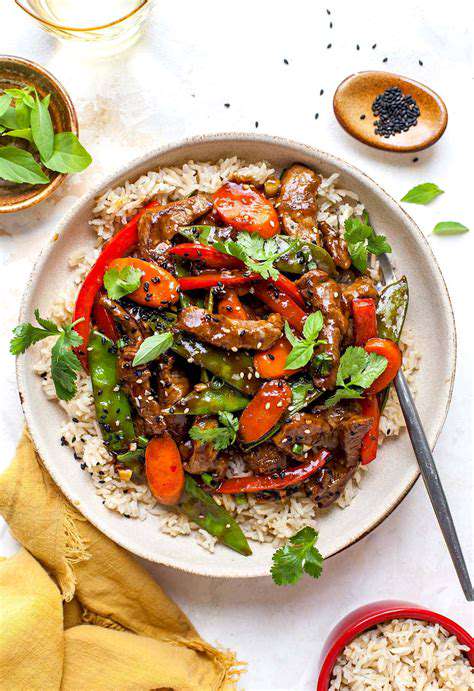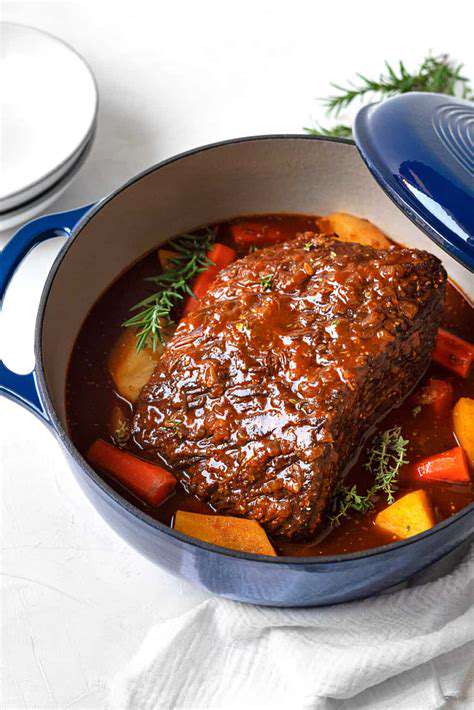Simple Beef Recipes: Versatile and Delicious

Beef Stir-Fry: A Delicious and Easy Weeknight Meal
Few dishes offer the perfect balance of speed and flavor like beef stir-fry. The magic of this dish lies in its adaptability - you can toss in whatever vegetables are lingering in your fridge or pantry. It's become my go-to solution for those evenings when time is tight but I still crave something nourishing. The sizzle of ingredients hitting a hot pan always signals the start of a satisfying meal.
Mastering a few simple techniques transforms this from basic to brilliant. I've found that proper ingredient preparation makes all the difference - uniform slices cook evenly, while a well-balanced sauce ties everything together. My neighbor, a retired chef, once shared his secret: Treat each ingredient with respect, and they'll reward you with flavor. This philosophy shines through in every successful stir-fry.
Essential Ingredients for a Perfect Stir-Fry
The foundation of any great stir-fry begins with quality components. I prefer flank steak for its balance of flavor and tenderness, though sirloin works beautifully too. The vegetable selection should include contrasting colors and textures - think vibrant bell peppers, crunchy snow peas, and earthy mushrooms. Last week, I discovered that adding thinly sliced water chestnuts creates a delightful crunch.
For the sauce, I've developed a personal blend that never fails to impress. Equal parts soy sauce and oyster sauce form the base, with a drizzle of sesame oil and a whisper of honey. The real game-changer came when I started adding a splash of rice vinegar - it brightens all the flavors remarkably. Fresh ginger and garlic, minced rather than powdered, make the aromatics truly sing.
Preparing the Beef for Stir-Fry
Cutting technique matters more than most people realize. I always chill the beef slightly before slicing - it firms up the meat, making thin cuts easier to achieve. Cutting across the grain shortens the muscle fibers, ensuring each bite stays tender. My grandmother taught me this method decades ago, and it's served me well in countless stir-fries.
The marinade works wonders if given time to penetrate. I combine soy sauce, a touch of cornstarch (for velveting), and a splash of Shaoxing wine when I have it. Fifteen minutes is good, but thirty minutes transforms the texture completely. Occasionally I'll add a pinch of baking soda - just a quarter teaspoon per pound - which helps break down proteins for exceptional tenderness.
Stir-Fry Technique: Mastering the Art of Cooking
Heat management separates adequate stir-fries from extraordinary ones. I preheat my wok until a drop of water evaporates instantly - that's when I know it's ready. Working in batches prevents overcrowding, which would steam rather than sear the ingredients. The satisfying hiss when ingredients hit the pan signals proper caramelization is occurring.
I keep everything moving with quick, confident motions - a combination of flipping and stirring that ensures even cooking. The rhythm becomes almost meditative after practice. Timing is crucial: vegetables should retain some bite, while beef needs just moments to reach perfect doneness. I've learned to trust my senses - when the aromas intensify and colors deepen, the dish is nearly ready.
Adding the Vegetables and Sauce
Vegetable sequencing makes all the difference. Denser vegetables like carrots go in first, followed by quicker-cooking items like bean sprouts. I add delicate greens at the very end, letting residual heat wilt them gently. This staggered approach ensures everything reaches ideal texture simultaneously.
The sauce moment is pure alchemy. When I pour it over the nearly-finished stir-fry, the liquid immediately thickens and coats each component in glossy perfection. A final toss distributes flavors evenly, while a quick taste test determines if it needs any last-minute adjustments. Sometimes a squeeze of lime or sprinkle of crushed red pepper provides that final flavor boost.
Serving and Enjoying Your Stir-Fry
Presentation elevates the experience. I arrange the stir-fry over steaming jasmine rice in a wide bowl, garnishing with sliced scallions and toasted sesame seeds. The contrast of colors and textures makes it as visually appealing as it is delicious. Eating immediately is crucial - that first bite when everything is piping hot captures the essence of stir-fry perfection.
This dish embodies the joy of cooking - quick yet thoughtful, simple yet deeply satisfying. Whether cooking for one or for a family, it never fails to deliver comfort and nourishment. The best part? Leftovers (if there are any) taste fantastic the next day, the flavors having melded even further overnight.
One-Pan Beef and Veggie Roast: Effortless Elegance

A Flavorful and Effortless Meal
Weeknight dinners call for solutions that minimize cleanup while maximizing flavor. This one-pan approach solves both challenges beautifully. The method creates magical chemistry - beef juices mingle with roasting vegetables, creating caramelized edges and deep, complex flavors. I discovered this technique during a particularly hectic semester in college, and it's remained in my regular rotation ever since.
The simplicity belies the sophisticated results. Strategic arrangement on the pan ensures everything cooks evenly - I place heartier root vegetables near the edges where heat concentrates. The first time I made this, the transformation of humble ingredients into something extraordinary surprised even me. Now I vary the vegetables seasonally - autumn brings squash and Brussels sprouts, while summer favors zucchini and cherry tomatoes.
Tips for Success and Variations
Temperature control proves crucial. I roast at 425°F (220°C) - hot enough to create beautiful browning but not so hot that the exterior burns before the interior cooks. A meat thermometer removes guesswork; I pull the beef at 135°F (57°C) for medium-rare, knowing carryover cooking will raise it another 5 degrees.
Seasoning layers build flavor. I rub the beef with a mix of salt, pepper, and smoked paprika at least an hour before cooking. The salt has time to penetrate, seasoning the meat throughout rather than just on the surface. For vegetables, I toss them with olive oil, garlic powder, and a pinch of sugar to promote caramelization.
Deglazing the pan creates a simple but impactful sauce. After removing the roast, I add a splash of broth or wine to the pan, scraping up the flavorful browned bits. Reduced slightly, this makes a delicious accompaniment that ties the whole dish together. For special occasions, I'll stir in a knob of butter at the end for added richness.
NSAIDs function by inhibiting cyclooxygenase enzymes, which are responsible for prostaglandin synthesis. This biochemical intervention effectively reduces inflammatory responses and pain perception throughout the body. The precise targeting of these enzymes explains NSAIDs' effectiveness in managing various types of headache discomfort.
Beef and Broccoli with Garlic Sauce: A Classic for a Reason

A Flavorful Fusion
This iconic dish represents the best of culinary adaptation. I first encountered it at a small neighborhood restaurant years ago, and the memory of that perfect balance of flavors inspired me to recreate it at home. The interplay between the rich beef and fresh broccoli creates textural harmony that's endlessly satisfying. What appears simple actually demonstrates thoughtful technique when executed well.
The sauce deserves particular attention. Through trial and error, I've refined my version to include chicken stock for depth, a touch of brown sugar for balance, and just enough cornstarch for ideal clinginess. The garlic should be noticeable but not overwhelming - I use three cloves for every pound of beef, minced finely and added at two different stages. This layering builds complexity in every bite.
Essential Ingredients and Preparation
Quality beef transforms the dish. I look for well-marbled cuts with good fat content - this ensures flavor and prevents dryness during quick cooking. Cutting technique matters here too; I slice the beef about 1/4 inch thick at a slight angle. This creates more surface area for the marinade to penetrate and gives pleasing texture.
Broccoli preparation affects the final result significantly. I separate florets into uniform sizes for even cooking, and always include some stem pieces - peeled and sliced, they offer delightful crunch. Blanching the broccoli briefly before stir-frying preserves its vibrant color and perfect texture. This extra step makes a noticeable difference in the finished dish's appearance and mouthfeel.
Serving Suggestions and Variations
Rice selection complements the dish. Jasmine rice's floral notes pair beautifully, while brown rice adds nuttiness. For special occasions, I'll serve it with crispy noodles for contrasting texture. The dish's simplicity allows for creative presentation - sometimes I arrange the beef and broccoli separately over the rice for visual appeal.
Alternative proteins work wonderfully. Chicken makes a lighter version, while shrimp adds briny sweetness. For vegetarian options, extra-firm tofu absorbs the sauce beautifully when pressed properly. Mushrooms, particularly shiitake or oyster varieties, contribute meaty texture and umami depth. The basic framework adapts gracefully to various dietary needs while maintaining its essential character.
- Storing Potatoes: Prevent Sprouting
- Healthy Meal Prep for Weight Loss: 5 Days of Deliciousness
- Exploring Italian Pasta Dishes: Beyond Spaghetti Bolognese
- Decadent Chocolate Chip Cookies: The Secret to Perfect Chewyness
- Vegetarian Meal Prep Bowls: Easy and Nutritious
- Low Carb Dinners: Keto Friendly Options
- Authentic Irish Stew: Hearty and Comforting
- High Protein Vegan Meals: Delicious Plant Based Power
- Keto Desserts: Guilt Free Sweet Treats
- Kitchen Hacks for Meal Prep: Save Time
- Buying Organic Produce: Is It Worth the Cost?
- Exploring Spanish Tapas Desserts: Churros and Flan